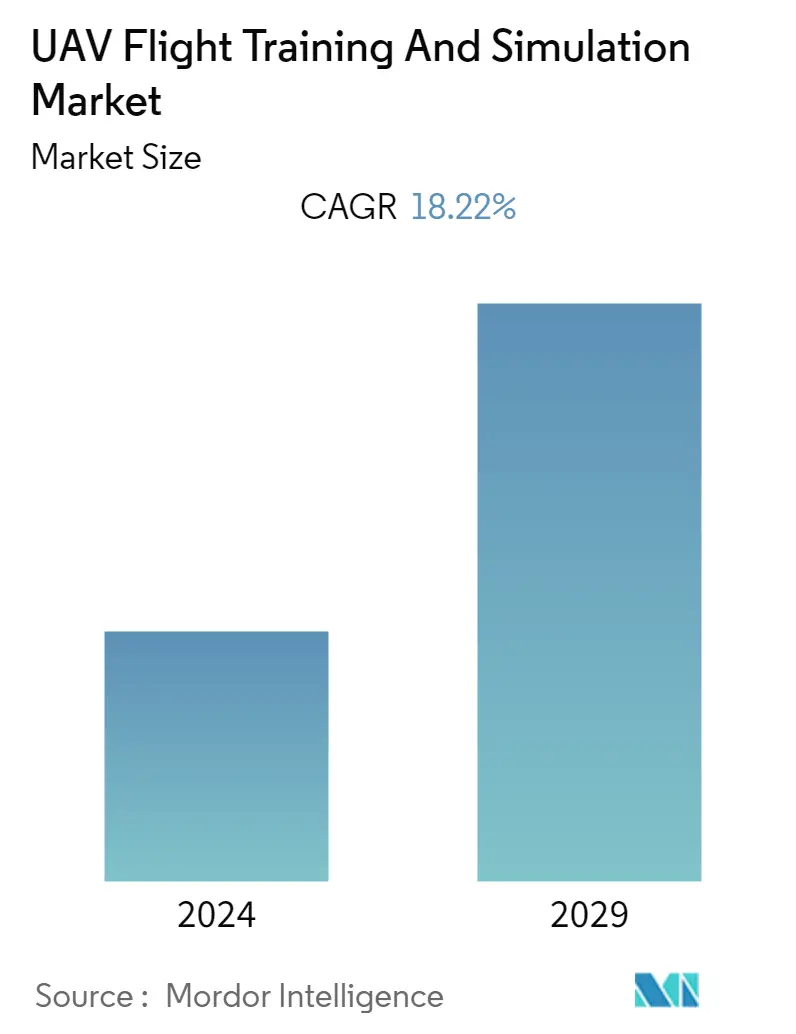Market Size of UAV Flight Training And Simulation Industry

| Study Period | 2019 - 2029 |
| Base Year For Estimation | 2023 |
| CAGR | 18.22 % |
| Fastest Growing Market | Asia Pacific |
| Largest Market | North America |
| Market Concentration | Low |
Major Players.webp)
*Disclaimer: Major Players sorted in no particular order |
UAV Flight Training and Simulation Market Analysis
The UAV flight training and simulation market was valued at USD 1.7 billion in 2022 and is anticipated to register a CAGR of 18.22% during the forecast period.
Over the short term, due to the COVID-19 pandemic, most countries had imposed a stay on the import and export of goods. But as the situation gets normalized all the countries have come back to normal conditions. Defense expenditure across the world witnessed an increase during the pandemic, and governments made significant investments in the development and deployment of drone and UAV technologies. As a result, there has been a visibly increased use of UAVs and simulators in defense and law enforcement agencies across the world. This is expected to last on a similar trend during the forecast period, rendering the COVID-19 pandemic having negligible effects on the market.
Defense forces across the globe are using unmanned systems and it is expected to grow significantly in the coming years. Deployment of UAVs in the military for special purpose operations and a growing number of civil applications such as policing and firefighting, and nonmilitary security work such as surveillance of pipelines are preferring UAVs.
UAVs are anticipated to become a main component of future urban air traffic. Government regulations, to a huge extent, determine the growth of the drone industry in any country. Countries with lesser restrictions on drones have witnessed increased adoption of drones, while countries with stricter regulations have witnessed smaller market growth in the last couple of years.
UAV Flight Training and Simulation Industry Segmentation
An unmanned aerial vehicle (UAV), commonly known as a drone, is an aircraft without any human pilot, crew, or passengers on board. UAVs are a component of an unmanned aircraft system (UAS), which includes adding a ground-based controller and a system of communications with the UAV. The flight of UAVs may operate under remote control by a human operator, as remotely-piloted aircraft (RPA), or with various degrees of autonomy, such as autopilot assistance, up to fully autonomous aircraft with no provision for human intervention.
The UAV flight training and simulation market is segmented by application and geography. By application, the market is segmented into military and law enforcement, and civil and commercial. By geography, the market is segmented into North America, Europe, Asia-Pacific, Latin America, and the Middle East and Africa. The report offers market size and forecasts for above all segments in USD million.
| Application | |
| Military and Law Enforcement | |
| Civil and Commercial |
| Geography | |
| North America | |
| Europe | |
| Asia-Pacific | |
| Latin America | |
| Middle East and Africa |
UAV Flight Training And Simulation Market Size Summary
The UAV flight training and simulation market is experiencing significant growth, driven by increased defense spending and the expanding use of unmanned aerial vehicles in both military and civil applications. The market is characterized by a robust demand for advanced training and simulation solutions, as governments and organizations worldwide invest in drone technologies for defense, law enforcement, and various commercial purposes. The COVID-19 pandemic initially disrupted global trade, but the subsequent rise in defense expenditure and the normalization of conditions have led to a surge in UAV adoption. This trend is expected to continue, with UAVs becoming integral to future urban air traffic and civil applications such as policing, firefighting, and surveillance. The market's expansion is also influenced by regulatory environments, with countries exhibiting fewer restrictions on drones witnessing faster growth.
North America currently leads the market, largely due to substantial military investments and the increasing use of UAVs for intelligence, surveillance, and reconnaissance missions. The region's dominance is supported by ongoing trials and the adoption of drones for commercial deliveries, such as those initiated by e-commerce giants like Amazon. The market is highly fragmented, with key players like CAE Inc., L3Harris Technologies Inc., and Northrop Grumman Corporation playing pivotal roles in providing simulation and training solutions. These companies are expanding their collaborations and technological offerings to enhance their market positions. The growing demand for UAV flight simulators, driven by the rising use of drones in various sectors, is expected to sustain the market's growth trajectory over the forecast period.
UAV Flight Training And Simulation Market Size - Table of Contents
-
1. MARKET DYNAMICS
-
1.1 Market Overview
-
1.2 Market Drivers
-
1.3 Market Restraints
-
1.4 Porter's Five Forces Analysis
-
1.4.1 Bargaining Power of Buyers/Consumers
-
1.4.2 Bargaining Power of Suppliers
-
1.4.3 Threat of New Entrants
-
1.4.4 Threat of Substitute Products
-
1.4.5 Intensity of Competitive Rivalry
-
-
-
2. MARKET SEGMENTATION
-
2.1 Application
-
2.1.1 Military and Law Enforcement
-
2.1.2 Civil and Commercial
-
-
2.2 Geography
-
2.2.1 North America
-
2.2.2 Europe
-
2.2.3 Asia-Pacific
-
2.2.4 Latin America
-
2.2.5 Middle East and Africa
-
-
UAV Flight Training And Simulation Market Size FAQs
What is the current UAV Flight Training And Simulation Market size?
The UAV Flight Training And Simulation Market is projected to register a CAGR of 18.22% during the forecast period (2024-2029)
Who are the key players in UAV Flight Training And Simulation Market?
CAE Inc., L3Harris Technologies Inc., Textron Inc., Northrop Grumman Corporation and Israel Aerospace Industries (IAI) Ltd. are the major companies operating in the UAV Flight Training And Simulation Market.

